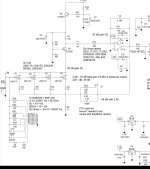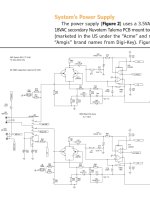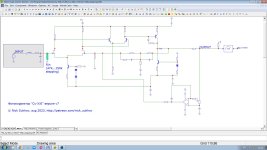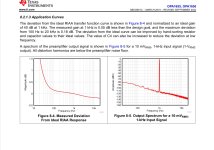I assume it is a noise with a MM cartridge related to 5mV/1kHz input. Is SNR 80.5dBA "fabulous", or just as good as to be expected?
It's about 1 dB better than what I get out of a simple calculation based on my 2003 article (*):
Assuming 27 degrees Celsius, 300.15 K, as that is the usual default temperature for SPICE-like simulators, neglecting the effect of the coupling capacitor, neglecting the extra noise current terms you get when you shift noise voltage sources past the 47 kohm resistor and taking only the 470 ohm of the feedback into account:
OPA1656:
4.3 nV/√Hz at 1 kHz. I should really be taking the density at 1169 Hz, but that should be very close.
47 kohm termination resistor:
As the 47 kohm is in parallel with the signal source, its thermal noise contributes to the equivalent input noise current. Taking the Norton equivalent of a noisy resistor, that's 0.593871 pA/√Hz for 47 kohm at 300.15 K.
The magnitude of the effective source impedance of the cartridge is the magnitude of its impedance at 3852 Hz, which is 12116.3 ohm.
The noise current has as big an impact as a |Zsource| times as large noise voltage, so 0.593871 pA/√Hz • 12116.3 ohm ~= 7.1955 nV/√Hz
Cartridge resistance thermal noise:
600 ohm at 300.15 K is 3.15367 nV/√Hz
This is bound to be underestimated, as the effective series resistance of a real cartridge rises with frequency. It's equally underestimated in the simulation, though.
Feedback resistor thermal noise:
The 470 ohm of the feedback network is more or less in series with the signal path and adds to the noise voltage: 2.79119 nV/√Hz
Total
Root of the sum of the squares: 9.38092 nV/√Hz
Over the 3219 Hz noise bandwidth of RIAA- and A-weighting (relative to the gain at 1 kHz), that's 532.238 nV RIAA- and A-weighted
This is -79.45728 dB with respect to 5 mV. It's pretty close, considering the fairly coarse approximations I used in the article.
Note that the biggest noise source is the 47 kohm termination resistor. It produces more noise than everything else together - but with underestimated cartridge thermal noise and no record surface noise.
(*): See "Noise and moving-magnet cartridges", Electronics World October 2003, pages 38...43, https://worldradiohistory.com/UK/Wireless-World/00s/Electronics-World-2003-10-S-OCR.pdf Mind you, Electronics World drew one of the sections of the gain switch in the wrong state in figure 5 and I mixed up the terms spectral density and power spectral density.
Maybe minor to those w/o subwoofers. 😊Very minor improvement in low-frequency noise and a better subsonic filter response (closer to maximally flat).
Regarding the difference between my 532.238 nV and Hans's 474 nV: about a quarter of the difference is due to the fact that A-weighting can be done with or without steep 20 kHz low-pass filter.
The calculations in my 2003 article assume exact RIAA weighting with a first-order 20 Hz high-pass and A-weighting without 20 kHz low-pass filter. Judging by the plot attached to post #327 (which is for the wrong value of the input capacitor and therefore shows a slightly higher noise than in the text of the post), Hans effectively uses A-weighting with a perfect high-pass at 20 Hz and perfect low-pass at 20 kHz.
With 20 Hz and 20 kHz limits and no first-order high-pass, the 3852 Hz changes into 3673.78 Hz and 3219 Hz becomes 3214.16 Hz (and the 1169 Hz becomes 1160.23 Hz). The effective cartridge impedance then drops to 11557.1 ohm, the noise contribution from the 47 kohm then changes into 6.86343 nV/√Hz and the total into 9.12869 nV/√Hz, 517.538 nV over the noise bandwidth, about 0.76 dB more than simulated. The 47 kohm is still the dominant noise source (with underestimated cartridge noise and no record surface noise).
The calculations in my 2003 article assume exact RIAA weighting with a first-order 20 Hz high-pass and A-weighting without 20 kHz low-pass filter. Judging by the plot attached to post #327 (which is for the wrong value of the input capacitor and therefore shows a slightly higher noise than in the text of the post), Hans effectively uses A-weighting with a perfect high-pass at 20 Hz and perfect low-pass at 20 kHz.
With 20 Hz and 20 kHz limits and no first-order high-pass, the 3852 Hz changes into 3673.78 Hz and 3219 Hz becomes 3214.16 Hz (and the 1169 Hz becomes 1160.23 Hz). The effective cartridge impedance then drops to 11557.1 ohm, the noise contribution from the 47 kohm then changes into 6.86343 nV/√Hz and the total into 9.12869 nV/√Hz, 517.538 nV over the noise bandwidth, about 0.76 dB more than simulated. The 47 kohm is still the dominant noise source (with underestimated cartridge noise and no record surface noise).
Last edited:
From realistic point of view, for which I deeply apologize, I doubt it would have made any sense.If you really want to make the signal-to-noise ratio larger, replace the 47 kohm resistor with an electrically cold resistance, as invented by William Spencer Percival in 1939.
If you don't care about the noise of the 47 kohm, surely the much smaller noise contribution of the OPA1656 should be perfectly acceptable?
IDK generally, but 80dB greatly exceeds my personal listening requirements. "Mastering level" of 85dB SPL at ear is insanely loud to me, but even at that, which would accommodate peaks of, say, 20dB, for peak SPL of 105dB SPL (classically recognized as 10th row orchestral level) 80dB falls at 25dB SPL, a room noise level that can be acheived but is very expensive, and may be seasonal.
Scaling down to a "VU" of 70 or 75 dB SPL (for a 90 to 100 dB SPL peak), loud to me, maybe not to you, moves the room noise requirement for 80dB S/N beyond reach. I'd also have to teach the cats to walk more quietly.
All good fortune,
Chris
Scaling down to a "VU" of 70 or 75 dB SPL (for a 90 to 100 dB SPL peak), loud to me, maybe not to you, moves the room noise requirement for 80dB S/N beyond reach. I'd also have to teach the cats to walk more quietly.
All good fortune,
Chris
No real vinyl record is able to distantly approach SNR we are speaking about. The whole discussion is purely academic and as such does not have a realistic point. However, I understand the passion for finding engineering limits, though they do not reflect in listening impressions.
Talking about engineering limits, then active damping at the preamp input gives even better SNR than the discussed 80.5dBA. Again, with no improvements during real vinyl record listening. Vinyl groove noise destroys all that efforts.
Talking about engineering limits, then active damping at the preamp input gives even better SNR than the discussed 80.5dBA. Again, with no improvements during real vinyl record listening. Vinyl groove noise destroys all that efforts.
Yep, that's an implementation of the electrically cold resistance Percival invented in 1939. You can find two more in my 2003 article.
By the way, record surface noise is mostly low-frequency noise that according to some (such as Nick Sukhov and krglee on this forum) sounds less annoying than the sharp noise you get from the equivalent input noise current, of which the 47 kohm is the most important cause as long as you don't do anything silly. The total A-weighted noise may therefore not tell the whole story.
By the way, record surface noise is mostly low-frequency noise that according to some (such as Nick Sukhov and krglee on this forum) sounds less annoying than the sharp noise you get from the equivalent input noise current, of which the 47 kohm is the most important cause as long as you don't do anything silly. The total A-weighted noise may therefore not tell the whole story.
Last edited:
In that case it is pointless doing things like paralleled jfets as in this Pearl 3 design??47 kohm is the most important cause as long as you don't do anything silly. The total A-weighted
Attachments
Marcel, even A-wtd noise with 47k is much more than with 100k and 150k as in my "passive cooling" (see attached MC12 simul) and even more so with your active cooling R3=1M from Fig.6 EWoktoba2003page4247 kohm is the most important cause as long as you don't do anything silly. The total A-weighted noise may therefore not tell the whole story.
Attachments
In that case it is pointless doing things like paralleled jfets as in this Pearl 3 design??
No, because it and Bonsai's circuit are also meant for moving-coil cartridges. Due to their much lower impedance, termination resistor noise plays much less of a role (hardly any, actually) with moving-coil cartridges.
Besides, even for a moving-magnet phono preamplifier, designing for a very low equivalent input noise voltage has an advantage: it leads to better results in Stereophile and ASR tests, as they measure noise with much too low source impedances.
Marcel, even A-wtd noise with 47k is much more than with 100k and 150k as in my "passive cooling" (see attached MC12 simul) and even more so with your active cooling R3=1M from Fig.6 EWoktoba2003page42
Without record surface noise, I agree. In fact, it's in line with my calculation. With record surface noise, I doubt it.
I first saw this configuration as an MC preamplifier in the 1997 Pass Labs Aleph ONO.No, because it and Bonsai's circuit are also meant for moving-coil cartridges.
Then in the first Pearl, the Pearl Phono Stage from 2001, followed by the Pearl 2 Phono Stage in 2010, which had a kind of afterburner, a discrete, simple op-amp as a second output stage ---> but basically they are intended and designed as MM-RIAA preamps.
+1Without record surface noise, I agree. In fact, it's in line with my calculation. With record surface noise, I doubt it.
I have just measured SNR 80.569dBA with Shure M35X cartridge (equal to 970 ohm + 425 mH) and a discrete phono preamp with complementary differential input with 2SK170/2SJ74 JFETs. So this seems to be at the limit of a phonopre MM system with 47k load resistor and no active damping.It's about 1 dB better than what I get out of a simple calculation based on my 2003 article (*):
Note: the system was calibrated before the measurement.
Marcel,Regarding the difference between my 532.238 nV and Hans's 474 nV: about a quarter of the difference is due to the fact that A-weighting can be done with or without steep 20 kHz low-pass filter.
The calculations in my 2003 article assume exact RIAA weighting with a first-order 20 Hz high-pass and A-weighting without 20 kHz low-pass filter. Judging by the plot attached to post #327 (which is for the wrong value of the input capacitor and therefore shows a slightly higher noise than in the text of the post), Hans effectively uses A-weighting with a perfect high-pass at 20 Hz and perfect low-pass at 20 kHz.
With 20 Hz and 20 kHz limits and no first-order high-pass, the 3852 Hz changes into 3673.78 Hz and 3219 Hz becomes 3214.16 Hz (and the 1169 Hz becomes 1160.23 Hz). The effective cartridge impedance then drops to 11557.1 ohm, the noise contribution from the 47 kohm then changes into 6.86343 nV/√Hz and the total into 9.12869 nV/√Hz, 517.538 nV over the noise bandwidth, about 0.76 dB more than simulated. The 47 kohm is still the dominant noise source (with underestimated cartridge noise and no record surface noise).
Another reason for the difference between our dBA values is the fact that the OPA1656 has in fact 2.9nV/rtHz and not the 4.3nV/rtHz that you mentioned.
But the knee frequency is at 1.2Khz, that's why 4.3nV/rtHz @1Khz has been specified.
I'm sure when you use these figures you will come even closer to the 80.5dBA.
Hans
Marcel,
Another reason for the difference between our dBA values is the fact that the OPA1656 has in fact 2.9nV/rtHz and not the 4.3nV/rtHz that you mentioned.
But the knee frequency is at 1.2Khz, that's why 4.3nV/rtHz @1Khz has been specified.
I'm sure when you use these figures you will come even closer to the 80.5dBA.
Hans
For my calculation, I need the voltage noise density at 1169 Hz or 1160.23 Hz (see the article for an explanation why). With a white noise floor of 2.9 nV/√Hz and enough 1/f noise to make it 4.3 nV/√Hz at 1 kHz, the correct figure should be 4.13496 nV/√Hz at 1160.23 Hz.
The total noise then decreases to 9.05212 nV/√Hz and the A-weighted noise with 20 Hz and 20 kHz limits to 513.197 nV, -79.77372 dB with respect to 5 mV. I didn't bother making this small correction yesterday because it was quite late, I forgot it this morning.
Last edited:
In my opinion these type of tests of MM stages using low source impedance are flawed… has anyone done more realistic tests? I guess maybe TI, when they presented the OPA1656 performance but then using 10mV levels instead of the standard 5mV 🤔Besides, even for a moving-magnet phono preamplifier, designing for a very low equivalent input noise voltage has an advantage: it leads to better results in Stereophile and ASR tests, as they measure noise with much too low source impedances.
Attachments
Noise measurements with much too low source impedances are indeed flawed, and even misleading. An amplifier with, for example, an LT1028 as input stage would pass the test with very good results, while it is about as bad as it gets for MM.
@PMA has done sensible tests, and I believe Philips also used to do sensible noise measurements when they still made consumer electronics. In fact, many classical MM RIAA amplifiers have a bipolar input stage biased at a few dozen microamperes of collector current, which is a clear indication that the designers knew what they were doing.
It does make sense to measure the frequency response with a low source impedance and to measure the input impedance. If both are as intended, the frequency response with a real cartridge should also be OK.
@PMA has done sensible tests, and I believe Philips also used to do sensible noise measurements when they still made consumer electronics. In fact, many classical MM RIAA amplifiers have a bipolar input stage biased at a few dozen microamperes of collector current, which is a clear indication that the designers knew what they were doing.
It does make sense to measure the frequency response with a low source impedance and to measure the input impedance. If both are as intended, the frequency response with a real cartridge should also be OK.
- Home
- Source & Line
- Analogue Source
- OPA1656 Phono Preamp: Split from OPA1656 thread




